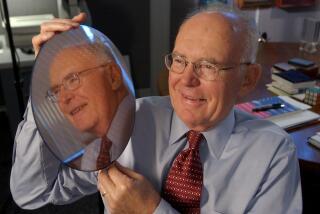Silicon Graphics Founder Quits to Launch New Software Firm
- Share via
James H. Clark, a former Stanford University professor who pioneered some of the most important technologies in contemporary computing, announced Thursday that he was stepping down as chairman of Silicon Graphics Inc., the Mountain View, Calif.-based company he founded.
Clark will likely be succeeded by longtime Silicon Graphics Chief Executive Ed McCracken, with whom Clark has had a highly productive--if sometimes difficult--relationship. The mild-mannered Clark, 49, said he is leaving Feb. 28 to start a new company that will develop software for the nascent interactive television market.
“These opportunities occur every 10 or 15 years--quantum leaps (in technology) that create fundamental new opportunities,” Clark said in an interview. “Entrepreneurship is the key to emerging technologies.”
Certainly, Clark’s achievements at Silicon Graphics count as spectacular entrepreneurship. A physicist by training, Clark was teaching at Stanford when he recognized a need among scientists for computer tools that would allow them to create visual representations of their formulas and models.
His only previous business experience, he said Thursday, was “a loan business in the Navy.” But together with six graduate students, he launched Silicon Graphics in 1982, and the company pioneered both hardware and software for three-dimensional graphics computing. The technology initially was extremely expensive and the market tiny, but the firm grew rapidly.
By the late 1980s, the company’s machines were revolutionizing everything from Hollywood special effects to automobile design.
But Clark and McCracken, a former Hewlett-Packard executive who was brought on board in 1984, nonetheless had a tough task in defending the company against far larger rivals even as it sought to expand beyond its high-end niche.
An alliance with Compaq Computer crumbled along with an industry consortium called ACE.
Silicon Graphics was later virtually obliged to acquire troubled MIPS Computer Systems, a microprocessor company whose chips were needed by Silicon’s computers.
But revenue and profits continued to climb.
Over the past two years, Clark has pushed to spread the company’s graphics technologies not only into the mainstream personal computer market, but into America’s living rooms as well.
Silicon Graphics is the key technology supplier for the Time Warner interactive television trial that will begin later this year in Orlando, Fla.
The firm is also developing a next-generation video game with Nintendo--a project that aims to bring the power of a 1980s supercomputer into low-cost game machines.
Clark said it was the opportunity to create software for all these new media that prompted his departure, noting that his new company would make heavy use of Silicon Graphics systems.
He firmly denied longstanding industry rumors of tension between him and McCracken, allegedly a result of McCracken’s growing authority at the company. “Whatever might have gone around with the wind has been greatly exaggerated,” Clark said. “There is no conflict . . . I’m going to be doing something that we couldn’t do here.”






